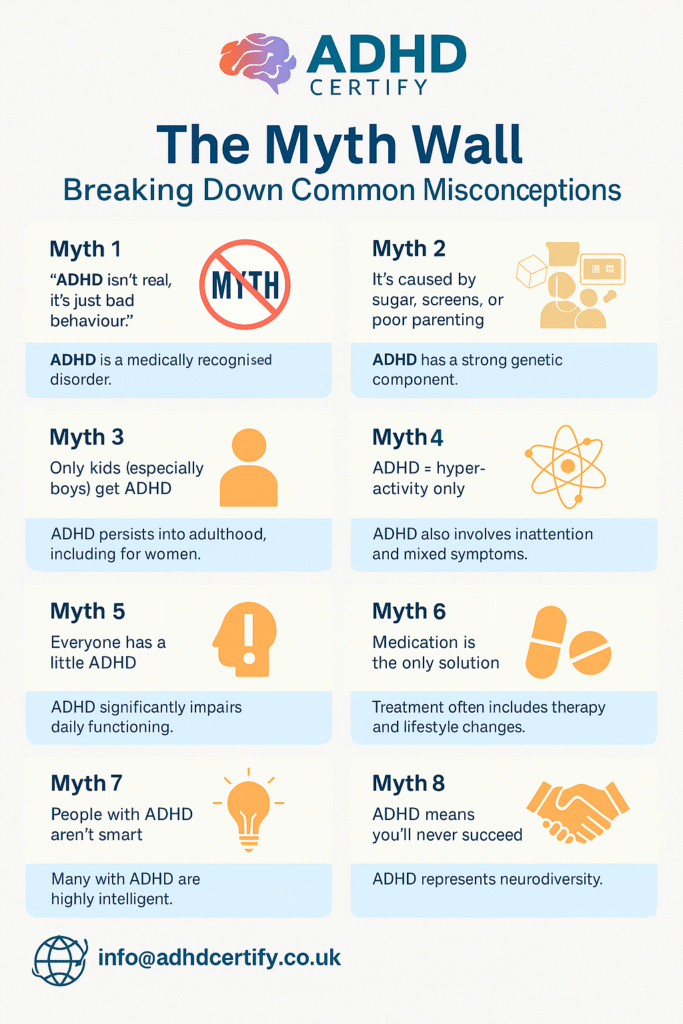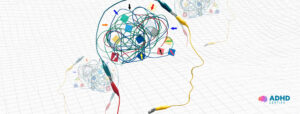Despite a growing public conversation around mental health, ADHD remains one of the most misunderstood and underestimated conditions. Especially when it shows up in adults. For many, it hides in plain sight, masked by years of coping strategies, self-doubt, or simply being mislabeled as forgetful, lazy, or emotionally “too much.”
Diagnosis often arrives late. Sometimes in your thirties, forties, or even fifties. Not as a revelation, but as a strange kind of relief. Suddenly, there’s a name for the lifelong restlessness, the lost keys, the missed deadlines, the emotional intensity, the sense that your brain just doesn’t operate the way others do.
And with that name comes a flood of questions, many of them tangled in myth and stigma.
This blog is for those standing at that threshold. It will discuss the common misconceptions about ADHD, break down what’s happening in the brain from a scientific lens, share surprising new findings, and draw from real stories, especially the ones that rarely get told.
And somewhere in that complexity, you might recognise this story, posted by a Reddit user trying to explain what their mind feels like on a normal day:
“I feel like I have 40 tabs open at a time in my brain and I’m just being randomly switched between them.” Reddit user.
For many adults with ADHD, that isn’t a metaphor. It’s just Monday.

The Myth Wall: Breaking Down Common Misconceptions
ADHD in adults is often missed, misunderstood, or mislabeled. Here’s what current science, lived experience and brain imaging studies tell us about how ADHD actually works.
Myth 1: “ADHD isn’t real, it’s just bad behavior.”
ADHD is a medically recognised neurodevelopmental disorder characterised by differences in brain structure and function, particularly in areas related to attention, impulse control, and executive functioning. It’s not a matter of willpower or discipline. [1]
Myth 2: “It’s caused by sugar, screens or poor parenting.”
While environmental factors can influence behavior, ADHD has a strong genetic component. Brain imaging studies have shown structural differences in individuals with ADHD, underscoring its biological basis. [2]
Myth 3: “Only kids (especially boys) get ADHD.”
ADHD persists into adulthood for many individuals. Moreover, girls and women often go undiagnosed due to less overt symptoms, leading to a significant gender gap in diagnosis. [3]
Myth 4: “People with ADHD just need to try harder.”
ADHD affects the brain’s executive functions, making tasks like organising, prioritising, and maintaining focus challenging. It’s not about effort; it’s about neurological differences that require understanding and support. [4]
Myth 5: “ADHD = hyperactivity only.”
ADHD presents in various forms. While some individuals exhibit hyperactivity, others primarily experience inattentiveness or a combination of symptoms. Recognising these variations is crucial for accurate diagnosis and treatment. [5]
Myth 6: “Everyone has a little ADHD.”
While many people experience occasional forgetfulness or distraction, ADHD involves persistent patterns that significantly impair daily functioning. It’s a clinical condition, not a personality quirk.
Myth 7: “Medication is the only solution.”
Treatment for ADHD often includes a combination of medication, behavioral therapy, lifestyle changes, and coping strategies. A holistic approach tailored to the individual’s needs tends to be most effective. [7]
Myth 8: “People with ADHD aren’t smart.”
Intelligence is not diminished by ADHD. Many individuals with this condition are highly intelligent and creative, excelling in various fields when provided with appropriate support and accommodations.
Myth 9: “ADHD means you’ll never succeed.”
With proper diagnosis and management, individuals with ADHD can lead successful, fulfilling lives. Recognising and harnessing their unique strengths is key to overcoming challenges.
Myth 10: “It’s a weakness, not a difference.”
ADHD represents a different way of processing information and interacting with the world. Embracing neurodiversity allows for a more inclusive understanding of human cognition and behaviour.
Inside the ADHD Brain: What the Science Shows
What does ADHD actually look like in the brain?
From dopamine imbalances to executive dysfunction and emotional swings, here’s what science and brain scans reveal about how ADHD really works.
The Chemistry: Neurotransmitter Differences
At the heart of ADHD is a chemical imbalance, primarily in dopamine and norepinephrine. These neurotransmitters help regulate focus, motivation, and reward. When they misfire, the brain struggles to sustain attention unless a task is naturally stimulating. It’s not about effort. It’s about access to fuel.
The Architecture: Brain Structure + Imaging
Neuroimaging reveals key differences in the prefrontal cortex (planning and decision-making), basal ganglia (reward and movement), limbic system (emotion regulation), and reticular activating system (attention filtering). PET and fMRI scans show these regions working differently in ADHD brains, not broken, but out of sync with neurotypical patterns.
The Control Panel: Executive Dysfunction
This is where ADHD hits hardest in daily life: managing time, starting tasks, remembering steps. It’s not forgetfulness, it’s a breakdown in the brain’s internal control panel. You know what to do, but can’t always initiate or sustain it. That’s executive dysfunction.
The Feelings: Emotional Regulation
Many adults with ADHD experience intense emotional swings, low frustration tolerance, and a deep sensitivity to perceived rejection. These aren’t overreactions, they’re signs of a brain that struggles to shift emotional states smoothly.
The Paradox: Hyperfocus vs. Paralysis
ADHD brings a strange contradiction: the ability to focus deeply on certain tasks (hyperfocus) while freezing on others (task paralysis). It’s not about distraction but about inconsistent regulation of attention. You can lock in or completely stall, depending on interest and context.
For newly diagnosed adults, understanding what’s going on under the hood can be strangely comforting. It turns the chaos into a map. And a map, after all, is something you can work with.
What New Research Reveals About the ADHD Brain
From brain scans to genetics, here’s what the latest research tells us about how ADHD works, and why it’s more than just a focus issue.
Default Mode Network Dysfunction
Ever zone out mid-task or lose time to daydreaming?
The default mode network, the brain’s “idle mode”, may be overactive in people with ADHD. It kicks in when it shouldn’t, pulling focus away from what you’re trying to do. You’re not distracted by choice; your brain is switching channels.
A typical Connectivity in Brain Circuits
Brain scans show that some regions in ADHD brains are over-connected, while others are under-synced. It’s not faulty wiring, just a different operating system. This helps explain why ADHD looks so varied person to person.
Genetics and Prenatal Influences
ADHD often runs in families. UK research confirms a strong genetic link, with intergenerational patterns appearing more strongly in families than environmental causes alone. If you have ADHD, it’s likely someone else in your family tree shows the same traits, diagnosed or not.
There are also prenatal and perinatal factors that may raise the risk, such as premature birth, low birth weight, or certain exposures in the womb. Additionally, being autistic has been linked to an increased likelihood of having ADHD, highlighting the overlap between these neurodevelopmental conditions. But ADHD rarely comes from one cause. It’s shaped by overlapping influences, both inherited and environmental.
Strengths Hidden in the Noise
Beneath the challenges, there’s creativity, rapid thinking, and spontaneity. ADHD minds often bring insight, energy, and adaptability; strengths that are easy to miss, but powerful when recognised.
What the ADHD Community Wishes You Knew
Behind missed appointments and half-finished texts isn’t carelessness, it’s often exhaustion. Many with ADHD grow up hearing they’re lazy or disruptive, long before diagnosis offers clarity. On forums like Reddit, users share the emotional toll of constantly masking their struggles to appear “normal,” often leading to burnout.
For women and girls, the path to diagnosis is even steeper. Internalised symptoms, such as daydreaming, anxiety, and perfectionism, often go unnoticed. Real posts from r/adhdwomen tell of misdiagnoses, shame, and finally, relief at being understood.
But alongside the hardship, the community has built tools. Visual timers. Body doubling. Whiteboards. Changing your environment instead of blaming yourself. People with ADHD don’t lack discipline, they just need different systems.
Neurodiversity, Not Deficiency
ADHD isn’t a flaw in effort. It’s a difference in wiring. The concept of neurodiversity reframes this; not as disorder, but as variation. Just as biodiversity strengthens an ecosystem, neurodiversity strengthens communities. This shift allows for compassion, not comparison.
Final Thoughts
If you’re newly diagnosed, overwhelmed, or still unsure, you’re not broken. The ADHD brain isn’t built for conformity. It’s built for possibility. Learn your patterns. Use what works. Leave shame at the door. This brain is wired for difference, not defeat.
Frequently Asked Questions
Is ADHD really a brain disorder or just an excuse for bad behaviour?
No, ADHD is a medically recognised neurodevelopmental condition with clear differences in brain structure and function, especially in areas linked to attention, impulse control, and motivation. It’s not about laziness, and it’s definitely not a character flaw.
I can focus when I’m interested in something. Does that mean I don’t have ADHD?
Actually, the ability to hyperfocus on things you love is classic ADHD. The challenge isn’t focus, it’s regulating what you focus on, especially when the task isn’t naturally stimulating.
I was diagnosed as an adult. Why wasn’t this caught when I was a kid?
Many adults, especially women and non-hyperactive types, go undiagnosed because ADHD symptoms can look like daydreaming, disorganisation, or even anxiety. It’s not rare for people to get missed in childhood and only realise what’s going on later in life.
Does ADHD go away, or is this forever?
ADHD doesn’t “go away,” but the way it shows up can change over time. With the right tools, meds, and support, many people learn to manage their symptoms, but it’s a lifelong brain difference, not a phase.
What’s the hardest part of ADHD that most people don’t understand?
The constant mental effort. People with ADHD often spend their whole day manually forcing focus, organising chaos, and masking their struggles. It’s exhausting, and mostly invisible to everyone else.




